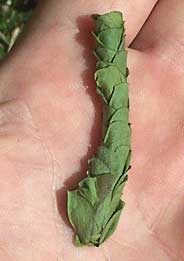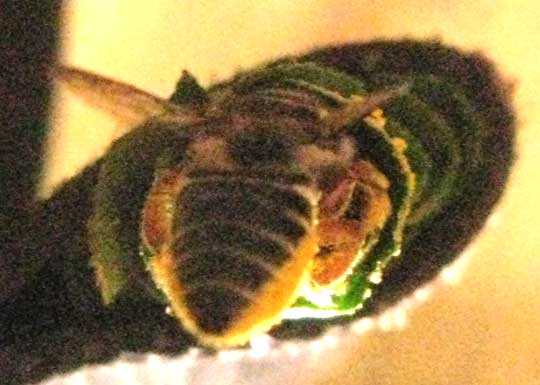Excerpts from Jim Conrad's
Naturalist Newsletter

from the April 1, 2012 on-the-road Newsletter based on notes and pictures from Hacienda Chichen Resort beside Chichén Itzá Ruins; limestone bedrock; elevation ~39m (~128ft), N20.675°, W88.569°; central Yucatán state, MÉXICO
LEAFCUTTER BEES
On my last day in the Yucatán I untied the rope that for so long had been suspending my backpack from the hut's ceiling, hopefully out of mind for nest-seeking rats and mice, and took my old backpack in hand. Ashes from daily campfires had settled all over it so I stepped outside and gave it a good whack. The resulting cloud was half ash and half green tatters of dried, coiled-up leaf-parts stuck together into tube-like affairs. The leaf tatters surprised me.
 But, I knew what they were, for back in 2006 during my stay at Genesis Retreat in Ek Balam, Yucatán, the Maya staff there had shown me the same thing. You can see the leafy, tube-like item whose picture I took then at the right, and read about that encounter in the next entry..
But, I knew what they were, for back in 2006 during my stay at Genesis Retreat in Ek Balam, Yucatán, the Maya staff there had shown me the same thing. You can see the leafy, tube-like item whose picture I took then at the right, and read about that encounter in the next entry..
A young Maya woman had told me that the green leaf-tube was a collection of nests stuck end-to-end, and that the tube construction itself was known by a special Maya name, which was pa'ak. The creature inside the cocoon was Jo'olon. I was told that a bee made the nest, but I hardly believed it.
But, now I believe her, for once I had disturbed all those nests in my roof-suspended backpack, hoards of bees came complaining, thumping against me and entangling themselves in my hair but never stinging. And they were surely the most unusual bees I've ever seen, for instead of carrying clumps of pollen on their back-leg "baskets," they transported it on hairs covering the entire bottoms of their abdomens. With their golden-yellow abdomen bottoms they look like dimly lit fireflies. You can the pollen-dusted lower abdomen on a bee entering its pa'ak cocoon, one stuffed into one of my backpack's looped belt-tips, in the hut's dim light, so it's a grainy picture, shown at the top of this page.
A rear view of the same bee showing golden pollen stuffed inside a green pa'ak tube is shown below:

So, this was my last Yucatán identification challenge for volunteer IDer Bea in Ontario. Here's what she came up with: It's a Leafcutter Bee. Many times we've spoken of leafcutter ants, but this was something new.
Leafcutter Bees, I find, are members of the genus MEGACHILE, and despite my ignorance of its existence that genus is one of the largest among bees, home to well over 500 species and over 50 subgenera. A list of insects of Río Lagartos, on the Yucatan Peninsula's northern coast (~N21.60°, ~W88.16°), Yucatán state includes eight species of Megachile leafcutter bees, but I can't say which species is shown here.
Of leafcutter bees I read that, exactly as we see with our pa'ak tubes, Megachile nests typically are composed of single long columns of cells constructed from cut-out leaf sections. Females place pollen or a pollen/nectar mix in each cell as food for the egg laid there, then the cell is capped so that a wall separates that cell from the next one. The larva hatching from the egg eats the food supply and after a few molts and maybe a period of hibernation spins a cocoon and pupates, emerging from the nest as an adult bee. Males are typically smaller than females and emerge before them. Males die shortly after mating but females survive for several weeks, building new nests.
What a fine last discovery to end my Yucatán days!
from the November 6, 2006 Newsletter issued from Genesis Retreat in Ek Balam, central Yucatán, MÉXICO
PA'AK & JO'OLON
 The other day I was presented with the item shown at the right.
The other day I was presented with the item shown at the right.
I've seen many instances of caterpillars, just before they metamorphose into resting pupae, constructing protective cocoons for themselves from leaves and leaflets, which they bound together with silk. Clearly I'd had such a thing deposited into my hand. This cocoon, however, was especially neatly done, at the top sealed with a flat leaflet like a tin can with a lid.
I asked Teri, one of the Maya workers at Genesis Retreat in Ek Balam, what she knew about it. She told me that in Maya the name for the green leaflet casing was Pa'ak, and the name for the creature inside the cocoon was Jo'olon. I referred to the creature inside as a worm, or gusano, but she insisted that it was like a bee, "una abeja." Amazingly, the name Pa'ak appeared to be a special word just for the leaf cocoon of this particular insect pupa, and no other.
Teri also told me that the bee-like thing inside was medicinal -- that it was fed to children to cure fear.
I tried to determine what kind of fear eating the creature cured but she said it's just fear, "susto." Once when I was among Nahuatl-speaking people in the central Mexican highlands a little girl developed what they called "susto," normally translated as "fear." A healer, or "curandera," was summoned. She first shook fragrant herbs, mostly mints, all around the little girl until the whole area became intensely fragrant, and then she went through quite a routine in order to get the little girl's shadow released from beneath the tree that had fallen on it. I asked what kind of shadow it was but could only ascertain that it wasn't a sun-shadow, but rather a spirit shadow we all have, and if that shadow gets stuck someplace we're in trouble. This shadow business apparently has nothing to do with our Jo'olon, but it does make me careful about accepting blindly that the fear Teri is speaking of is the fear we northerners conceive of.
These Maya folks are wonderful, friendly, soft-spoken and hard working, but I don't make the mistake in thinking that I understand the mental world they live in, not in the least.